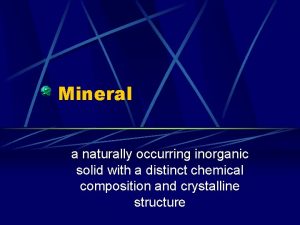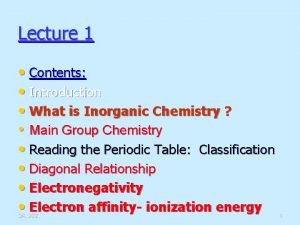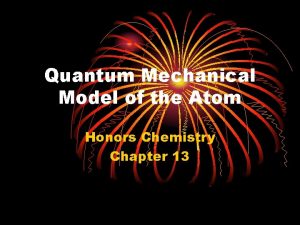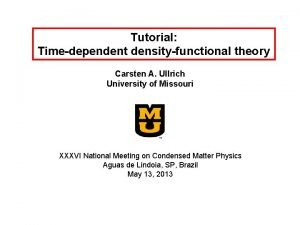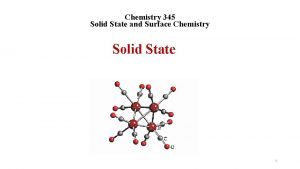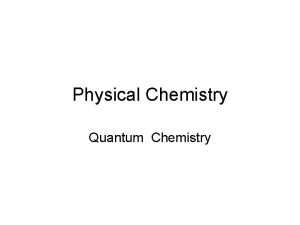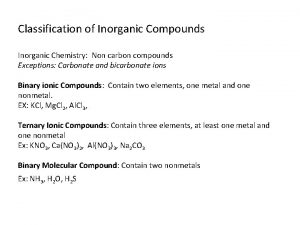CHE30042 Inorganic Physical Solid State Chemistry Advanced Quantum


















- Slides: 18

CHE-30042 Inorganic, Physical & Solid State Chemistry Advanced Quantum Chemistry: lecture 2 Rob Jackson LJ 1. 16, 01782 733042 r. a. jackson@keele. ac. uk www. facebook. com/robjteaching @robajackson

Lecture 2 contents 1. Trial wavefunctions and expectation values 2. The Variation Principle 3. Recap. on Molecular Orbitals: the hydrogen molecule ion 4. Molecular Orbitals for diatomic molecules 5. Secular Determinants che-30042 Advanced QC lecture 2 2

Trial wavefunctions and expectation values – (i) • In quantum chemistry, one of the main problems faced is determining the wavefunction of an atom or molecule. • If the ground state energy of a molecule is E 0, we expect the following to apply (if we know the wavefunction): H 0 = E 0 0 – Remember that this means that H acts on the wavefunction of the ground state to give the energy of the ground state. che-30042 Advanced QC lecture 2 3

Trial wavefunctions and expectation values – (ii) • Normally we can’t solve the Schrödinger equation analytically, so what do we do? • If we choose a ‘trial wavefunction’, , (a guess at what the wavefunction should be), we can define the energy associated with the wavefunction as: E = H d / d • This is called the Expectation Value of the energy. – notation: * means ‘complex conjugate’, and means ‘all space’ che-30042 Advanced QC lecture 2 4

The Variation Principle • If we use a trial wavefunction, , and calculate the expectation value of the energy, how can we judge our choice of wavefunction? • The Variation Principle states that: – For any trial wavefunction, the expectation value of the energy can never be less than the true ground state energy. • This is expressed as E 0 H d / d – The expectation value is only E 0 if the trial wavefunction is equal to the true one. che-30042 Advanced QC lecture 2 5

Why is the Variation Principle useful? • It enables different trial wavefunctions to be tested and evaluated, since the wavefunction giving the lowest energy expectation value should be closest to the true wavefunction. • For the hydrogen atom we know the ground state energy so the variation principle can be tested for different wavefunctions. • A reference to an example calculation will be given and discussed. che-30042 Advanced QC lecture 2 6

Molecular orbitals for H 2+ - (i) • For H 2+ we have 2 1 s atomic orbitals, each centred on a H atom. • We can form a trial wavefunction by combining the 1 s orbitals A and B. – Remember molecular orbital diagrams here! • This can be written as = N ( A B) – Here, N is a normalising constant. • The expectation value for the energy will be: E = (N )2 ( A B) H ( A B) d che-30042 Advanced QC lecture 2 7

Molecular orbitals for H 2+ - (ii) • The 2 molecular orbitals + , - are the bonding and antibonding orbitals in the H 2+ molecule. • In Hayward’s book there is a more detailed derivation, using expressions for the 1 s orbitals A and B (pp. 141 -145) • The shape of the wavefunction and the potential energy diagram will be shown and discussed in the lecture (see also Hayward figures 8. 2, 8. 3, pp. 142 -3). che-30042 Advanced QC lecture 2 8

Illustration of formation of H 2+ orbitals http: //catalog. flatworldknowledge. com/bookhub/reader/15739? e=averill_1. 0 ch 09_s 03 che-30042 Advanced QC lecture 2 9

Molecular orbitals for diatomic molecules – (i) • We can follow the same procedure for diatomic molecules as demonstrated for H 2+: • If the molecule is AB (i. e. different nuclei) we can suggest a trial wavefunction based on orbitals on atoms A and B: = c. A A + c. B B (where c. A, c. B are weighting coefficients) • The expectation value for the energy of this trial wavefunction will be (see definition on slide 5): E = H d / d che-30042 Advanced QC lecture 2 10

Molecular orbitals for diatomic molecules – (ii) • We will assume that the wavefunctions are not ‘complex’, so * = – Substituting for the wavefunction gives: E = (c. A A + c. B B) H (c. A A + c. B B) d / (c. A A + c. B B)2 d – On p. 150 of Hayward’s book, the expression is expanded to give: E = (c 2 AHAA + 2 c. Ac. BHAB + c 2 BHBB)/ (c 2 ASAA + 2 c. Ac. BSAB + c 2 BSBB ) – Here HAA, HAB, HBB, SAA, SAB and SBB are all integrals which are defined in the book and the next slide: che-30042 Advanced QC lecture 2 11

Overlap, Coulomb and Resonance integrals • The terms in the 2 nd equation, slide 10 are: SAA = A A d , SBB = B B d ( =1 for normalised orbitals) SAB = A B d = SBA = B A d (Overlap integrals) – The value depends on the amount of orbital overlap. HAA = A H A d , HBB = B H B d – Coulomb integral, the energy an electron would have in a particular orbital. HAB = A H B d = HBA = B H A d – Resonance integrals, = 0 if there is no overlap. che-30042 Advanced QC lecture 2 12

So how do we get the energy? • We need to evaluate the integrals, and get the values of c. A and c. B that give the lowest energy (Variation Principle). • The general approach to this will be explained (not restricted to diatomics), and applied to specific cases. • We start by writing the trial wavefunction as a linear combination of atomic orbitals: i = k cik k • So a trial wavefunction for a triatomic molecule would look like: i = ci 1 1 + ci 2 2 + ci 3 3 che-30042 Advanced QC lecture 2 13

Obtaining the secular determinant – (i) • Writing down the Schrödinger equation gives: H k cik k = i k cik k • Rearranging (moving H inside the summation sign): k cik H k = i k cik k • Multiplying both sides by l: k cik l H k = i k cik l k • Finally integrate over all electron positions: k cik l H k d = i k cik l k d • The integrals in bold we have already seen on slide 11. che-30042 Advanced QC lecture 2 14

Obtaining the secular determinant – (ii) • We define: Hlk = l H k d and Slk = l k d • The expression at the bottom of slide 13 becomes: k cik Hlk= i k cik Slk • Rearranging gives: k cik (Hlk- i Slk) = 0 • Using a mathematical rule, the above expression implies that: det Hlk- Slk = 0 (‘det’ means determinant) – This will be explained for a diatomic molecule che-30042 Advanced QC lecture 2 15

The secular determinant for a diatomic molecule (i) • We expand our trial wavefunction (molecular orbital) in terms of 2 atomic orbitals: i = ci 1 1 + ci 2 2 • If there are 2 AOs there will be 2 MOs: 1 = c 11 1 + c 12 2 2 = c 21 1 + c 22 2 • Following slide 14 this leads to 2 equations: c 11(H 11 - 1 S 11) + c 12(H 12 - 1 S 12) = 0 c 21(H 21 - 2 S 21) + c 22(H 22 - 2 S 22) = 0 che-30042 Advanced QC lecture 2 16

The secular determinant for a diatomic molecule (ii) • The energy for each orbital i is obtained from: H 11 - S 11 H 12 - S 12 = 0 H 21 - S 21 H 22 - S 22 • This is the secular determinant for a diatomic molecule. • This can be expanded to get a quadratic equation which can be solved to give , provided we know Hlk and Slk. • This method can be used to get the secular determinant for any molecule (which can be solved by a computer !) • Energies of orbitals can be obtained in this way. che-30042 Advanced QC lecture 2 17

Lecture summary • The Expectation Value of a property has been introduced and defined. • The Variation Principle has been introduced and explained. • Molecular Orbitals for H 2+ and diatomic molecules in general have been calculated. • Coulomb, Overlap and Resonance integrals have been defined • Secular Determinants have been introduced. che-30042 Advanced QC lecture 2 18
 Advanced inorganic chemistry lecture notes
Advanced inorganic chemistry lecture notes Inorganic chemistry vs organic chemistry
Inorganic chemistry vs organic chemistry Naturally occurring inorganic solid
Naturally occurring inorganic solid Importance of pharmaceutical inorganic chemistry
Importance of pharmaceutical inorganic chemistry Ch4o organic or inorganic
Ch4o organic or inorganic Inert pair effect
Inert pair effect Fazan rule
Fazan rule Classical mechanics
Classical mechanics Quantum physics vs quantum mechanics
Quantum physics vs quantum mechanics Quantum mechanical model definition chemistry
Quantum mechanical model definition chemistry Postulates of quantum mechanics
Postulates of quantum mechanics Quantum chemistry
Quantum chemistry Crystalline or amorphous
Crystalline or amorphous Solve example
Solve example Covalent molecular and covalent network
Covalent molecular and covalent network Crystalline solid
Crystalline solid Crystal solid and amorphous solid
Crystal solid and amorphous solid Crystalline solid and amorphous solid
Crystalline solid and amorphous solid Anisotropy
Anisotropy


